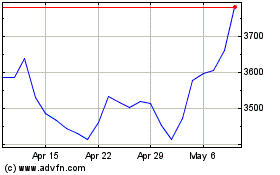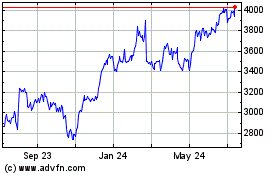Only 2 Left in Stock! Order Now!' But Does That Really Work? -- Journal Report
March 27 2020 - 4:37PM
Dow Jones News
By Christopher S. Tang
Anyone who has bought a book on Amazon.com or made other online
purchases is familiar with the message: "Only 2 left in stock --
order soon."
These days, because of the coronavirus crisis, customers are
finding all sorts of products with little or nothing left in stock.
This doesn't reflect a marketing strategy from the sellers of these
products.
In more normal times, however, such "quantity scarcity" messages
can serve a valuable purpose for online merchants. Because online
shopping makes it easy to compare prices, many potential buyers
will put off making a purchase decision while they check out prices
elsewhere or wait for a discount to be offered. Scarcity messages
give shoppers an extra nudge to buy without delay by making them
fear they might miss out if they don't.
But do such messages really work?
My research -- with Sungho Park, Elliot Rabinovich, and Rui Yin
of Arizona State University -- found that scarcity messages work
best with time-sensitive and perishable products such as hotel
rooms or plane tickets, as well as unique items like collectibles
or limited editions.
They are less effective with durable goods such as
home-improvement products or kitchenware, in part because they can
give shoppers the impression that the product is being pushed
because it is undesirable, lower quality, obsolete or discontinued.
And in the case of items typically bought in larger quantities,
such as partyware, lightbulbs and batteries, we found that scarcity
messages can actually hurt sales by making shoppers believe they
won't be able to buy as much of a product as they want.
That said, any retailer can enjoy the advantages of scarcity
messages while avoiding the negatives -- if they do it right. Here
are some of the steps they should consider.
Spotlight quality
The key, with durable goods in particular, is to use additional
measures to amplify the shoppers' psychological trigger to buy
immediately. For instance, retailers can counter the impression
that a product is undesirable or low quality by sharing customer
ratings and reviews, posting the number of shoppers looking at the
item at a given moment and the number of units sold in the past
day. To ease concerns that the item is being discontinued (perhaps
because it was unpopular), the merchant can state whether the item
is being replenished.
When posting scarcity messages, travel site Booking.com, for
instance, shows the information about the number of people who
viewed the room during the past hour, as well the number of rooms
booked at that hotel during the day. Amazon might tell shoppers
when extra copies of a book will be available in addition to the "2
items left" message. (Amazon declined to comment.)
Instill a sense of urgency
Because durable goods are neither time-sensitive nor perishable,
sellers should induce "time urgency" by launching sales events that
last just a short period in addition to posting the scarcity
message. A seller could display a countdown clock showing the hours
and minutes until the sale ends as a way to nudge shoppers to buy
right away.
Amazon, during flash-sale events, will let shoppers know what
percentage of the items have been claimed and include a countdown
showing when the event will end -- say, "in 1 hour and 5 minutes."
In some cases, Amazon will also offer faster shipment free if
shoppers can commit to making a purchase within a few minutes. By
intensifying time urgency, these mechanisms can increase sales
rates, recent research shows.
Offer a bundle
With clearance items, it can be hard to get rid of the last few
items in stock using scarcity messages alone because shoppers may
think these clearance items are undesirable or low quality. Sellers
could try packaging the clearance item with complementary products
that move faster, and selling the bundle at a lower price than the
two items together.
In January, for example, Amazon bundled its remaining inventory
of seasonal Christmas Poinsettia Party plates with Hefty plastic
cups, a year-round seller. Similarly, booksellers could post a
scarcity message about the number of copies left of a book written
by an author years ago and bundle that book with a popular book
written by the same author.
One final, if obvious, point: Don't lie. Sellers can't afford
the loss of trust if consumers find that the notices of scarcity
aren't true. Even when they are true, the credibility of the
scarcity messages can suffer -- and shoppers can get tired of
seeing them -- if they are used too often.
Dr. Tang is a UCLA distinguished professor and Edward W. Carter
chair in business administration at the UCLA Anderson School of
Management. He can be reached at reports@wsj.com.
(END) Dow Jones Newswires
March 27, 2020 16:22 ET (20:22 GMT)
Copyright (c) 2020 Dow Jones & Company, Inc.
Booking (NASDAQ:BKNG)
Historical Stock Chart
From Mar 2024 to Apr 2024

Booking (NASDAQ:BKNG)
Historical Stock Chart
From Apr 2023 to Apr 2024
